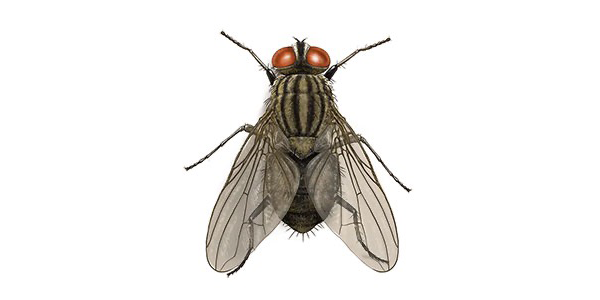10 Common Types of Flies Found in Businesses: Do You Know the Difference?
When you’re seeing flies around your facility, you’re seeing the signs of an underlying problem — and it’s not one you can just swat away. When it comes to managing flies around your business, knowing the type of fly you’re dealing with is half the battle. Different flies have different preferences for food and breeding sites, so identifying the species is critical to help solve the problem.
Flies can negatively affect your business and ultimately hurt your bottom line by irritating customers, transmitting diseases and contaminating products. Here’s a rundown of the ten most common flies you may find in your workplace and how to tell them apart:
1. House flies are the most encountered fly. House flies can be identified by four lengthwise stripes on the middle part of their body behind the head.

2. Blow flies are also called green bottle flies because of their shiny, metallic looking abdomens. Their larvae can develop in walls or even inside rodents caught in traps.
3. Fruit flies often lay their eggs near ripening fruits and vegetables. You might see this tiny fly — averaging an 1/8 of an inch long — near fermented materials in trash cans and floor drains.
4. Drain flies are covered with long hairs and are very weak flyers. They prefer to crawl along damp surfaces such as drains and clogged gutters. Drain flies need standing water to breed and commonly lay eggs in raw sewage under slabs where pipes might be broken.
5. Phorid flies are easily recognized by their humped backs and are 1/4 of an inch long. They are most often found in hospitals and restaurants.
6. Fungus gnats are small flies that often accompany office plants — fungus growing in damp soil provides a food source for this fly’s larvae. They fly low to the ground, close to plants and soil.
7. Cluster flies — also known as attic flies — measure about 8-10 millimeters; have light and dark gray-checkered abdomens; short, golden hairs on their thorax and wings that overlap when at rest. Many people refer to them as large, black flies as they are slightly bigger and darker than the house fly. Cluster flies also tend to move more sluggishly.
While not often found in commercial environments, here are three additional common types of flies to keep an eye out for:
8. Horse flies are large, aggressive flies that can inflict painful bites on animals and humans. Usually black or gray in color, they vary in length from about 1/2 to 1 1/4 inches long. While not known to transmit diseases, horse flies’ painful bites can cause allergic reactions and even secondary bacterial infections.
9. Flesh flies also look like house flies but are generally larger; they are gray with a checkerboard pattern on the top of their abdomen. Three black stripes run along the top surface of their thorax, and there is sometimes a reddish-brown tip at the end of the abdomen.
10. Crane flies are often mistaken for mosquitoes but are significantly larger with extremely long legs and elongated faces. Adult crane flies are black, red or yellow in color, depending on the species.
Don’t Let Flies Face Off With Your Business
Working with a pest management professional to inspect your property is the best way to make sure you identify a potential fly problem and manage the infestation correctly. After determining the species of fly affecting your business, you can partner to create and implement the most effective treatment plan. Read our other Field Notes blogs about why flies are bad for your business and how you can help manage and treat them. To learn more about keeping these dirty pests out of your facility, download our free Comprehensive Guide to Flies & Fly Control Strategy.
Orkin’s Fly Control services apply our deep knowledge of flies to help ensure your business is above standard. After assessing your problem, we'll propose a tailored fly management plan that aligns with your business' unique needs. Contact Orkin today to sign up for a free inspection.